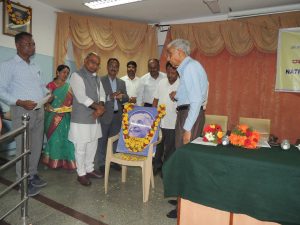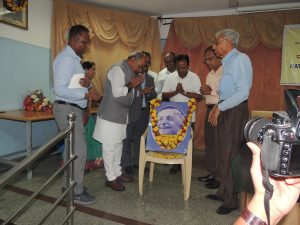
“Inputs / Suggestions to Draft NEP – 2019”
Vivekananda Degree college under the aegis of Janatha Education Society conducted a symposium on 25th July 2019 inviting inputs from stake holders, academicians, linguistic faculties, Parents & students for incorporation in the draft NEP – 2019 to tune the education demands in accordance with the constitutional aspirations.
In the symposium Prof.Sripad Bhat highlighted non-participation of the grass root level stake holders and mentioned that committee members are also not drawn from all the regions of the country. The draft committee is not comprising all the regions of the country. Also the draft is not printed in all the languages recognized by constitution. Later, to pacify this problem only selective printing of certain features of the draft is done. On account of selective printing of certain salient features of the draft in other languages may not suffice to give the full recipe of draft NEP-2019. So entire draft should be translated to know the entire matter of the draft NEP 2019.
 Overall, the draft is highly centralized, not allowing the participation of the states curtailing the rights of the states. This is a threat on the federal principle. It breaks constitutional structures and promotes commercialisation, politicing and commodification of education system. Even in the federal system, individual states can have its own system with in the national frame work policy. No such provisions are highlightened. The contents are all stereo typical based on superficial ideas failing to address the core and systematic values / issues of education system.
Overall, the draft is highly centralized, not allowing the participation of the states curtailing the rights of the states. This is a threat on the federal principle. It breaks constitutional structures and promotes commercialisation, politicing and commodification of education system. Even in the federal system, individual states can have its own system with in the national frame work policy. No such provisions are highlightened. The contents are all stereo typical based on superficial ideas failing to address the core and systematic values / issues of education system.
One can see the clear lapse on the part of the authority without following the bottom-up approach and not collecting the public opinion constructively.
Draft clearly says educational institutions have to be non-profit and shall meet the demands of the society. But how far this is applicable to foreign universities establishing in India in HE domain.
 There is a saying in Rigveda “Let noble thoughts come to us from all sides”. In contrary draft has drawn entire features from ancient India at the same time neglecting the inputs from medieval India. Instead of extracting the best, it is confined / restricting to a particular part. Draft has kept aside some of the successful novel ideas by natural selection over along period of time.
There is a saying in Rigveda “Let noble thoughts come to us from all sides”. In contrary draft has drawn entire features from ancient India at the same time neglecting the inputs from medieval India. Instead of extracting the best, it is confined / restricting to a particular part. Draft has kept aside some of the successful novel ideas by natural selection over along period of time.
In the Pre-School system anganwadi centers are centers of care and cannot be considered a school.
Anganwadi teachers are over burdened with non-teaching work or even working in places with poor- infrastructure. Large amount of time is spent currently on non-teaching activities and other strenuous administrative work. Anganwadis must be strengthened with supporting staff (ministrial staff) to augument teacher to involve with the children. This should be supported by legislative that is rigorously monitored effectively.
The present draft treats Anganwadis as a learning unit for children. Research reveals that we can strengthen the learning through play in early childhood. This spoils the early childhood development and also make the children not ready for their primary education. There should be really play-way situation fairly large play ground with necessary apparatus. The children learn better by way of play. The alphabets, nursery rhymes and songs be taught and it should not be tiring and burdensome. So that it ensures the integration of pre-school with primary school.
 In the foundation level how ECCE is sensitive and responsive to this specially challenged children? Children dropouts arising from ECCE have not been addressed properly in the interest of inclusive education. Including training of Anganawadi workers in identifying needs of the children with disabilities. Also the medium of instructions should include sign language for children with hearing impairment & Braille for children with visual impairment. Children at the early age are prone to diseases. Children should be given appropriate and free physical examination by health care authorities. At the same time survey should be undertaken regularly for socially disadvantaged class. In the learning environment should be salubrious to the disabled children so that they feel “Goodness fit”.
In the foundation level how ECCE is sensitive and responsive to this specially challenged children? Children dropouts arising from ECCE have not been addressed properly in the interest of inclusive education. Including training of Anganawadi workers in identifying needs of the children with disabilities. Also the medium of instructions should include sign language for children with hearing impairment & Braille for children with visual impairment. Children at the early age are prone to diseases. Children should be given appropriate and free physical examination by health care authorities. At the same time survey should be undertaken regularly for socially disadvantaged class. In the learning environment should be salubrious to the disabled children so that they feel “Goodness fit”.
With regard to HE, classifying HE institutions into world class research Universities, teaching universities and UG teaching colleges will widen the gap between research institutions and universities. In the restructuring, linkage between 3 types of institutions is not mentioned. Soon after the higher education students must be provided with internship and opportunity windows for employment. Closing non-attending B.Ed., and diploma colleges is not a favourable idea. Instead it should be included in ODL (Open distance learning. ) so that students who are occupied with jobs and other monetary constraints are benefitted and also helps in increasing GER to 50% by 2035.
We have to allow the cross-fertilization professional development for teaching and research bringing symbiotic relation between them..
With Autonomous status, universities are free to charge exorbitrarily for professional course. This problem will be aggravated with the entry of foreign universities.
As per as governance and expenditure, good innovative financing schemes have been proposed, involving the private sector, how these schemes will shape up remains unanswered. Draft proposal establishing new institutions for Pali, Prakrit and Persian appears to be good idea. Instead, Central Institute of Indian languages Mysore could be elevated to university to take care and nurture of these languages. DNEP-2019 introduces plethora of programmes in order to enrich the institutions with excellence, introducing emerging areas like artificial intelligence, Robotics technology. But the financial support is not up to the expectations of the budget. As a testimony to this central government spending on education has declined from 3.1% of GDP in 2012-13 to 2.7 in 2017-18. In contrary to this, china spends over 4% of its GDP on education.
We hope these inputs will find place in DNEP-2019
***********************
